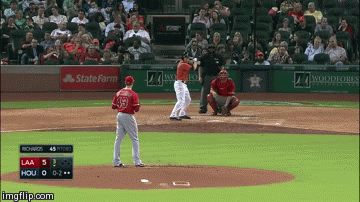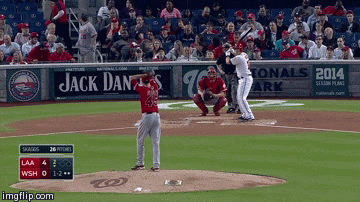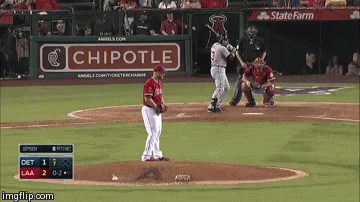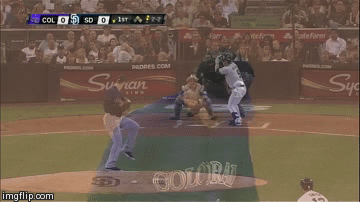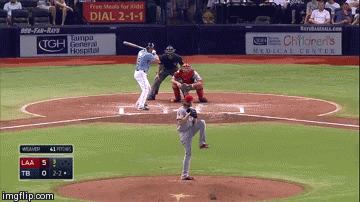Analyzing the FanGraphs’ Mock Draft from an Outsider’s Point of View — 1B
As an avid reader of FanGraphs, I’ve been following the ongoing mock draft and thought it would be interesting to compare the results to the dollar value rankings I created using Steamer’s 2015 projections.
I downloaded the draft spreadsheet partway through the 16th round, just after pick 183 (Chase Headley). Here is a breakdown, position-by-position. I’ve included the overall pick and the dollar value for that player based on 2015 Steamer projections in parentheses.
First Base
Four first basemen were taken in the first round: Miguel Cabrera (4th–$48), Paul Goldschmidt (6th–$36), Jose Abreu (8th–$35), and Edwin Encarnacion (10th–$36). After Cabrera is off the board, the next three guys are almost identical in value, according to Steamer. At this point, it becomes the preference of the owner. Goldy and Abreu are younger than Encarnacion and should hit for a better average with similar production in the HR/RBI department, so it makes sense to see them go ahead of Edwin, but there really isn’t much difference among them.
In the second round, Freddie Freeman (18th–$24) went before Anthony Rizzo (21st–$29) in what could be considered a questionable selection. Steamer likes Rizzo over Freeman by $5 in value. Below are their respective projections for 2015:
560 AB, 81 R, 24 HR, 83 RBI, 3 SB, .284 AVG—Freeman ($24)
541 AB, 85 R, 30 HR, 89 RBI, 6 SB, .271 AVG—Rizzo ($29)
Rizzo has Freeman beat in every category except for average.
Let’s look at their average stats over the last two years (since Rizzo has only played full seasons over the last two years):
579 AB, 91 R, 20 HR, 94 RBI, 2 SB, .303 AVG—Freeman
565 AB, 80 R, 28 HR, 79 RBI, 6 SB, .258 AVG—Rizzo
This tells a different tale, as Freeman now has the edge in runs, RBI, and average, with Rizzo leading in homers and steals. Another factor is the outlook for their respective teams. The Cubs look to have a much better offense than the Braves, which should allow Rizzo to score and drive in more runs. I would have gone for Rizzo before Freeman.
Five more first basemen were taken in rounds 4, 5, and 6: Albert Pujols (47th–$22), Victor Martinez (48th–$26), Adrian Gonzalez (53rd–$22), Joey Votto (61st–$16), and Prince Fielder (72nd–$23).
Based on past history, I believe you have to take Pujols, Martinez, and Gonzalez before Votto and Fielder. Votto played in just 62 games last season and doesn’t have the power you’d like to get from a first baseman. Fielder played in just 42 games and is coming off major surgery that included having his neck bones fused together. His production was already dropping before the injury, so he really is a question mark for 2015.
Back to Pujols, Martinez, and Gonzalez: Steamer likes V-Mart the best of the three and he is coming off a terrific season (.335, 87 R, 32 HR, 103 RBI), but is also heading into his age 36 season (Pujols will be 35, Gonzalez will be 33).
Let’s look at what they’ve done over the last three seasons (seasonal averages):
544 AB, 74 R, 25 HR, 91 RBI, 5 SB, .273 AVG—Pujols
569 AB, 77 R, 19 HR, 96 RBI, 1 SB, .321 AVG—Martinez
601 AB, 76 R, 22 HR, 108 RBI, 1 SB, .290 AVG—Gonzalez
It’s close. There’s enough of a range of outcomes with all three hitters that they could finish the season in any order.
Rounds 7 through 9 saw four more first baseman get drafted, starting with Carlos Santana, taken with the 77th pick. Here I’m not sure of the league specifications. For my dollar values, I have Santana only eligible at first base (94 game played in 2014) or third base (26 games played). He did play 10 games at catcher. If he’s only eligible at first base or third base, I have him worth $8. If he’s eligible at catcher, his value jumps to $21 based on positional scarcity. Anyway, the four first baseman taken here were Santana (77th–$8), Chris Davis (79th–$13), Lucas Duda (105th–$5), and Steve Pearce (106th–$17).
Steamer 2015 projections:
490 AB, 74 R, 21 HR, 73 RBI, 4 SB, .245 AVG—Carlos Santana ($8)
483 AB, 71 R, 30 HR, 79 RBI, 3 SB, .242 AVG—Chris Davis ($13)
534 AB, 69 R, 24 HR, 75 RBI, 3 SB, .234 AVG—Lucas Duda ($5)
514 AB, 77 R, 23 HR, 74 RBI, 6 SB, .270 AVG—Steve Pearce ($17)
Again, Santana is much more valuable if you can slot him at catcher. Davis is a big risk considering he had by far the worst year of any of these players in 2014 (.196, 65 R, 26 HR, 72 RBI, 2 SB), but he also has the highest ceiling, having hit 53 homers with a .286 average in 2013. Duda had a breakout 2014 season, hitting 30 homers and driving in 92 runs last year. Steamer sees regression to 23 and 74 in 2015. Of these four players, Steve Pearce had the best rate stats in 2014 (.293/.373/.556) and best wRC+ (161). He’s projected for a career-high 586 plate appearances in 2015. Consider the Orioles have an open spot for him to be an everyday player after losing Nelson Cruz and Nick Markakis in the offseason, if you expect Pearce to get the playing time, he’s your guy. My order for these four players would be Pearce, Davis, Santana, and Duda (unless Santana has catcher eligibility).
The next four first basemen could be right up there with the previous group, based on Steamer projections: Ryan Zimmerman (120th–$11), Mark Trumbo (135th–$12), Justin Morneau (163rd–$14), and Eric Hosmer (166th–$17). The projections:
508 AB, 70 R, 19 HR, 71 RBI, 3 SB, .275 AVG—Ryan Zimmerman ($11)
526 AB, 67 R, 29 HR, 81 RBI, 4 SB, .246 AVG—Mark Trumbo ($12)
479 AB, 68 R, 19 HR, 74 RBI, 2 SB, .295 AVG—Justin Morneau ($14)
573 AB, 76 R, 19 HR, 77 RBI, 7 SB, .278 AVG—Eric Hosmer ($17)
With Zimmerman, you have to worry about his health, as he only played in 61 games last year. He also had the lowest HR/FB% of his career, at 7.8%. In 2012 and 2013, he hit 25 and 26 home runs, so he could bounce back and be just fine. Trumbo played in just 88 games last year and hit 14 homers after back-to-back seasons of 30 or more. Steamer expects him to bounce back to 29 homers, albeit with a low batting average. Morneau is the oldest of this bunch, at 34 years old, but has the Coors Field advantage and should hit for the best batting average. Hosmer is the youngest of this bunch (25), but is also coming off a bad year rate-stat wise (.270/.318/.398).
The interesting thing to notice is that this group of four, taken in rounds 10-14, is projected to be similar to the previous group of four, taken in rounds 7-9. There’s a difference of 90 picks between Santana at 77 and Hosmer at 166, but little difference in their projections, with Hosmer actually projecting better.
Final Notes: The top four of Miggy, Goldschmidt, Abreu, and Encarnacion are a tier above Freeman and Rizzo. Then you have Pujols, Martinez, and Gonzalez, with the wild cards of Votto and Fielder fitting in just below them. Beyond that, I’d expect diverse opinions when it comes to Santana, Davis, Duda, Pearce, Zimmerman, Trumbo, Morneau, and Hosmer. Davis is the most volatile. Pearce could be a late-bloomer, like Jose Bautista. Santana is likely the most predictable but is much more valuable if he can be played at catcher than first base, while Zimmerman and Trumbo are coming off injury-shortened years.
